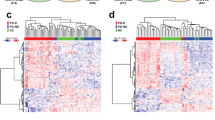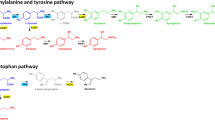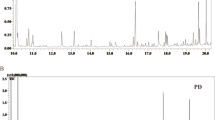Abstract
Levodopa-induced dyskinesias (LID) in Parkinson’s disease (PD) are frequent complications, and the endocannabinoid system has a role on its pathophysiology. To test the hypothesis that the functioning of the endocannabinoid system would be altered in PD and in LID by measuring plasma and CSF levels of α-N-arachidonoylethanolamine (AEA) and 2-arachidonoyl-glycerol (2-AG) in patients with PD with and without LID and in healthy controls. Blood and CSF samples were collected from 20 healthy controls, 23 patients with PD without LID, and 24 patients with PD with LID. The levels of AEA and 2-AG were measured using a highly sensitive column switching ultrahigh-performance liquid chromatography–tandem mass spectrometry method. When pooled together, patients with PD had lower plasma and CSF levels of 2-AG and higher CSF levels of AEA compared to healthy controls (Mann–Whitney statistics = 303.0, p = 0.02). Patients with PD without LID had lower CSF levels of 2-AG (Kruskal–Wallis statistics = 7.76, p = 0.02) and higher CSF levels of AEA levels than healthy controls (Kruskal–Wallis statistics = 8.81, p = 0.01). The findings suggest that the endocannabinoid system participates in the pathophysiology of PD symptoms, but its role in the pathophysiology of LID is still unclear.


Similar content being viewed by others
Data availability
The datasets generated during and/or analyzed during the current study are available from the corresponding author on reasonable request.
Code availability
Not applicable.
References
Baggelaar MP, Maccarrone M, van der Stelt M (2018) 2-Arachidonoylglycerol: a signaling lipid with manifold actions in the brain. Prog Lipid Res 71:1–17
Cenci MA, Riggare S, Pahwa R, Eidelberg D, Hauser RA (2020) Dyskinesia matters. Mov Disord 35:392–396
Covey D, Mateo Y, Sulzer D, Cheer JF, Lovinger DM (2017) Endocannabinoid modulation of dopamine neurotransmission. Neuropharmacology 124:52–61
Di Marzo V, Hill MP, Bisogno T, Crossman AR, Brotchie JM (2000) Enhanced levels of endogenous cannabinoids in the globus pallidus are associated with a reduction in movement in an animal model of Parkinson's disease. FASEB J 14:1432–1438
Dos-Santos-Pereira M, da-Silva CA, Guimaraes FS, Del-Bel E (2016) Co-administration of cannabidiol and capsazepine reduces L-DOPA-induced dyskinesia in mice: possible mechanism of action. Neurobiol Dis 94:179-195
Emre M, Aarsland D, Brown R, Burn DJ, Duyckaerts C, Mizuno Y, Broe GA, Cummings J, Dickson DW, Gauthier S, Goldman J, Goetz C, Korczyn A, Lees A, Levy R, Litvan I, McKeith I, Olanow W, Poewe W, Quinn N, Sampaio C, Tolosa E, Dubois B (2007) Clinical diagnostic criteria for dementia associated with Parkinson's disease. Mov Disord 22:1689–1707
Espay AJ, Morgante F, Merola A, Fasano A, Marsili L, Fox SH, Bezard E, Picconi B, Calabresi P, Lang AE (2018) Levodopa-induced dyskinesia in Parkinson disease: Current and evolving concepts. Ann Neurol 84:797–811
Ferreira Junior NC, Dos-Santos-Pereira M, Guimarães FS, Del Bel E (2020) Cannabidiol and cannabinoid compounds as potential strategies for treating Parkinson's disease and L-DOPA-induced dyskinesia. Neurotox Res 37:12–29
Ferrer B, Asbrock N, Kathuria S, Piomelli D, Giuffrida A (2003) Effects of levodopa on endocannabinoid levels in rat basal ganglia: implications for the treatment of levodopa-induced dyskinesias. Eur J Neurosci 18:1607–1614
Garcia C, Palomo-Garo C, Gomez-Galvez Y, Fernandez-Ruiz J (2016) Cannabinoid-dopamine interactions in the physiology and physiopathology of the basal ganglia. Br J Pharmacol 173:2069–2079
Giuffrida A, McMahon LR (2010) In vivo pharmacology of endocannabinoids and their metabolic inhibitors: therapeutic implications in Parkinson's disease and abuse liability. Prostaglandins Other Lipid Mediat 91:90–103
Goetz CG, Tilley BC, Shaftman SR, Stebbins GT, Fahn S, Martinez-Martin P, Poewe W, Sampaio C, Stern MB, Dodel R, Dubois B, Holloway R, Jankovic J, Kulisevsky J, Lang AE, Lees A, Leurgans S, LeWitt PA, Nyenhuis D, Olanow CW, Rascol O, Schrag A, Teresi JA, van Hilten JJ, LaPelle N (2008a) Movement Disorder Society-sponsored revision of the Unified Parkinson's Disease Rating Scale (MDS-UPDRS): scale presentation and clinimetric testing results. Mov Disord 23:2129–2170
Goetz CG, Nutt JG, Stebbins GT (2008b) The Unified Dyskinesia Rating Scale: presentation and clinimetric profile. Mov Disord 23:2398–2403
Gubellini P, Picconi B, Bari M, Battista N, Calabresi P, Centonze D, Bernardi G, Finazzi-Agrò A, Maccarrone M (2002) Experimental parkinsonism alters endocannabinoid degradation: implications for striatal glutamatergic transmission. J Neurosci 22:6900–6907
Hoehn MM, Yahr MD (1967) Parkinsonism: onset, progression, and mortality. Neurology 17:427–442
Hughes AJ, Daniel SE, Blankson S, Lees AJ (1993) A clinicopathologic study of 100 cases of Parkinson's disease. Arch Neurol 50:140–148
Kano M (2014) Control of synaptic function by endocannabinoid-mediated retrograde signaling. Proc Jpn Acad Ser B Phys Biol Sci 90:235–250
Leweke FM, Giuffrida A, Koethe D, Schreiber D, Nolden BM, Kranaster L, Neatby MA, Schneider M, Gerth CW, Hellmich M, Klosterkötter J, Piomelli D (2007) Anandamide levels in cerebrospinal fluid of first-episode schizophrenic patients: impact of cannabis use. Schizophr Res 94:29–36
Maccarrone M, Gubellini P, Bari M, Picconi B, Battista N, Centonze D, Bernardi G, Finazzi-Agrò A, Calabresi P (2003) Levodopa treatment reverses endocannabinoid system abnormalities in experimental parkinsonism. J Neurochem 85:1018–1025
Maccarrone M, Rossi S, Bari M, De Chiara V, Fezza F, Musella A, Gasperi V, Prosperetti C, Bernardi G, Finazzi-Agrò A, Cravatt BF, Centonze D (2008) Anandamide inhibits metabolism and physiological actions of 2-arachidonoylglycerol in the striatum. Nat Neurosci 11:152–159
Marchioni C, de Souza ID, Grecco CF, Crippa JA, Tumas V, Queiroz MEC (2017) A column switching ultrahigh-performance liquid chromatography-tandem mass spectrometry method to determine anandamide and 2-arachidonoylglycerol in plasma samples. Anal Bioanal Chem 409:3587–3596
Marchioni C, de Souza ID, Acquaro VRJ, de Souza Crippa JA, Tumas V, Queiroz MEC (2018) Recent advances in LC-MS/MS methods to determine endocannabinoids in biological samples: Application in neurodegenerative diseases. Anal Chim Acta 1044:12–28
Mechoulam R, Parker LA (2013) The endocannabinoid system and the brain. Annu Rev Psychol 64:21–47
Morgese MG, Cassano T, Cuomo V, Giuffrida A (2007) Anti-dyskinetic effects of cannabinoids in a rat model of Parkinson's disease: role of CB(1) and TRPV1 receptors. Exp Neurol 208:110–119
Mounsey RB, Mustafa S, Robinson L, Ross RA, Riedel G, Pertwee RG, Teismann P (2015) Increasing levels of the endocannabinoid 2-AG is neuroprotective in the 1-methyl-4-phenyl-1,2,3,6-tetrahydropyridine mouse model of Parkinson's disease. Exp Neurol 273:36–44
Perez-Lloret S, Negre-Pages L, Damier P, Delval A, Derkinderen P, Destée A, Meissner WG, Tison F, Rascol O (2017) L-DOPA-induced dyskinesias, motor fluctuations and health-related quality of life: the COPARK survey. Eur J Neurol 24:1532–1538
Piccolo M, Claussen MC, Bluemel S, Schumacher S, Cronin A, Fried A, Goetze O, Martin-Soelch C, Milos G (2020) Altered circulating endocannabinoids in anorexia nervosa during acute and weight-restored phases: a pilot study. Eur Eat Disorders Rev 28:46–54
Pisani A, Fezza F, Galati S, Battista N, Napolitano S, Finazzi-Agrò A, Bernardi G, Brusa L, Pierantozzi M, Stanzione P, Maccarrone M (2005) High endogenous cannabinoid levels in the cerebrospinal fluid of untreated Parkinson's disease patients. Ann Neurol 57:777–779
Pisani V, Moschella V, Bari M, Fezza F, Galati S, Bernardi G, Stanzione P, Pisani A, Maccarrone M (2010) Dynamic changes of anandamide in the cerebrospinal fluid of Parkinson's disease patients. Mov Disord 25:920–924
Pisani V, Madeo G, Tassone A, Sciamanna G, Maccarrone M, Stanzione P, Pisani A (2011) Homeostatic changes of the endocannabinoid system in Parkinson's disease. Mov Disord 26:216–222
Poewe W, Seppi K, Tanner CM, Halliday GM, Brundin P, Volkmann J, Schrag AE, Lang AE (2017) Parkinson disease. Nat Rev Dis Primers 3:17013
Rojo-Bustamante E, Abellanas MA, Clavero P, Thiolat ML, Li Q, Luquin MR, Bezard E, Aymerich MS (2018) The expression of cannabinoid type 1 receptor and 2-arachidonoyl glycerol synthesizing/degrading enzymes is altered in basal ganglia during the active phase of levodopa-induced dyskinesia. Neurobiol Dis 118:64–75
Sierra S, Luquin N, Rico AJ, Gómez-Bautista V, Roda E, Dopeso-Reyes IG, Vázquez A, Martínez-Pinilla E, Labandeira-García JL, Franco R, Lanciego JL (2015) Detection of cannabinoid receptors CB1 and CB2 within basal ganglia output neurons in macaques: changes following experimental parkinsonism. Brain Struct Funct 220:2721–2738
Tomlinson CL, Stowe R, Patel S, Rick C, Gray R, Clarke CE (2010) Systematic review of levodopa dose equivalency reporting in Parkinson's disease. Mov Disord 25:2649–2653
van der Stelt M, Fox SH, Hill M, Crossman AR, Petrosino S, Di Marzo V, Brotchie JM (2005) A role for endocannabinoids in the generation of parkinsonism and levodopa-induced dyskinesia in MPTP-lesioned non-human primate models of Parkinson's disease. FASEB J 19:1140–1142
Wang Y, Zhang QJ, Wang HS, Wang T, Liu J (2014) Genome-wide microarray analysis identifies a potential role for striatal retrograde endocannabinoid signaling in the pathogenesis of experimental L-DOPA-induced dyskinesia. Synapse 68:332–343
Wang Y, Zhang GJ, Sun YN, Yao L, Wang HS, Du CX, Zhang L, Liu J (2018) Identification of metabolite biomarkers for L-DOPA-induced dyskinesia in a rat model of Parkinson's disease by metabolomic technology. Behav Brain Res 347:175–183
Acknowledgements
We would like to thank Ângela Vieira Pimentel, Larissa Serveli, Manuelina Macruz Capelari and Nathália Novaretti (Ribeirão Preto Medical School, University of São Paulo) for technical support.
Funding
This study was supported by the Fundação de Amparo à Pesquisa do Estado de São Paulo (FAPESP; 159688/2015–9) and Conselho Nacional de Desenvolvimento Científico e Tecnológico (CNPq; 2012/17626–7).
Author information
Authors and Affiliations
Contributions
All authors contributed to the study conception and design. In detail: conceptualization: CM, BLS-L, MECQ, VT; methodology: CM, BLS-L, MECQ, VT; clinical data collection: BLS-L, VT; endocannabinoid analysis: CM, MECQ; formal analysis and investigation: CM, BLS-L, MECQ, JASC, VT; writing—original draft preparation: CM, BLS-L; writing—review and editing: CM, BLS-L, MECQ, JASC, VT; funding acquisition: MECQ, VT; supervision: MECQ, VT.
Corresponding author
Ethics declarations
Conflict of interest
Dr. CRIPPA is co-inventor (Mechoulam R, Zuardi AW, Kapczinski F, Hallak JEC, Guimarães FS, Crippa JA, Breuer A) of the patent ‘Fluorinated CBD compounds, compositions and uses thereof. Pub. No.: WO/2014/108,899. International Application No.: PCT/IL2014/050,023′, Def. US no. Reg. 62,193,296; 29/07/2015; INPI on 19/08/2015 (BR1120150164927). The University of São Paulo has licensed the patent to Phytecs Pharm (USP Resolution No. 15.1.130002.1.1). The University of São Paulo has an agreement with Prati-Donaduzzi (Toledo, Brazil) to ‘develop a pharmaceutical product containing synthetic cannabidiol and prove its safety and therapeutic efficacy in the treatment of epilepsy, schizophrenia, Parkinson’s disease, and anxiety disorders’. Dr. CRIPPA has received travel support from BSPG-Pharm and is a medical advisor of SCBD Centre. Dr. CRIPPA has a grant from University Global Partnership Network (UGPN)–Global priorities in cannabinoid research excellence. Dr. CRIPPA is a member of the international advisory board of the Australian Centre for Cannabinoid Clinical and Research Excellence (ACRE), funded by the National Health and Medical Research Council through the Centre of Research Excellence. Dr. CRIPPA is recipient of CNPq 1A productivity fellowship. Dr. TUMAS received honoraria from Teva Brasil, UCB Biopharma and Ipsen, and travel support for medical conferences from Roche.
Ethics approval
The study was approved by institutional review board of the Ribeirão Preto Medical School (Number 3.036.243), and each participant provided written informed consent to participate.
Consent to participate
Authors declare that informed consents for participation were obtained from all participants. Moreover, informed consents for lumbar pucture examination were also obtained from all participants.
Consent for publication
Authors declare that consent for publication of blinded data was a part of informed consents obtained from participants.
Additional information
Publisher's Note
Springer Nature remains neutral with regard to jurisdictional claims in published maps and institutional affiliations.
Electronic supplementary material
Below is the link to the electronic supplementary material.
Rights and permissions
About this article
Cite this article
Marchioni, C., Santos-Lobato, B.L., Queiroz, M.E.C. et al. Endocannabinoid levels in patients with Parkinson’s disease with and without levodopa-induced dyskinesias. J Neural Transm 127, 1359–1367 (2020). https://doi.org/10.1007/s00702-020-02240-9
Received:
Accepted:
Published:
Issue Date:
DOI: https://doi.org/10.1007/s00702-020-02240-9




